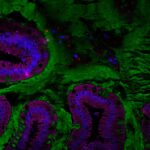Link to Pubmed [PMID] – 31162610
Link to DOI – 10.1093/femsre/fuz013
FEMS Microbiol Rev 2019 Sep; 43(5): 457-489
A close symbiotic relationship exists between the intestinal microbiota and its host. A critical component of gut homeostasis is the presence of a mucus layer covering the gastrointestinal tract. Mucus is a viscoelastic gel at the interface between the luminal content and the host tissue that provides a habitat to the gut microbiota and protects the intestinal epithelium. The review starts by setting up the biological context underpinning the need for experimental models to study gut bacteria-mucus interactions in the digestive environment. We provide an overview of the structure and function of intestinal mucus and mucins, their interactions with intestinal bacteria (including commensal, probiotics and pathogenic microorganisms) and their role in modulating health and disease states. We then describe the characteristics and potentials of experimental models currently available to study the mechanisms underpinning the interaction of mucus with gut microbes, including in vitro, ex vivo and in vivo models. We then discuss the limitations and challenges facing this field of research.


